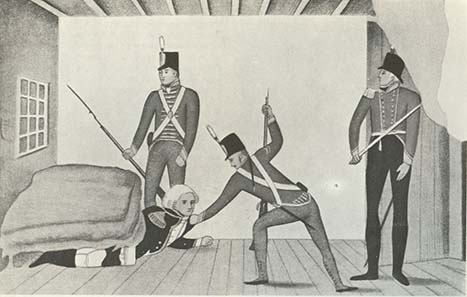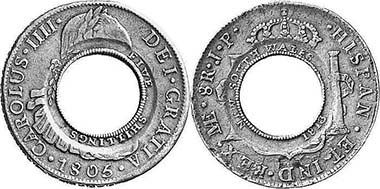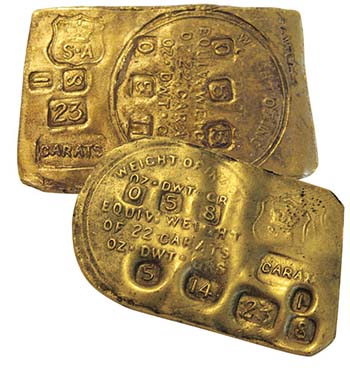The Rum Rebellion
When Captain Philipp’s small fleet reached Botany Bay in 1788, there were enough people on board to form a colony but nobody had considered money.
However, a generally accepted currency was needed. Rum was ideally suited for that. The navy had enormous supplies. And many workers were longing for a drink to take their minds off their daily troubles. In brief, the soldiers who had been sent to the new world as the New South Wales Corps by His Majesty the King of England were soon known simply as the “Rum Corps”.
Thus was the situation when William Bligh (oh yes, the very one from the Mutiny on the Bounty) arrived in Australia. He saw speculators and military officers co-operating to ruin the free farmers. Bligh fought against this. He prohibited, among other things, the use of rum as a currency.
Bligh is being arrested – propagandist caricature portraying Bligh as a coward. Sydney in 1808. State Library of New South Wales. Photo: Wikipedia.
The local notables did not put up with this. John Macarthur, the colony’s leading captain of industry, drafted a petition requesting the commander of the “Rum Corps” to arrest Bligh and assume responsibility for New South Wales. This is exactly what happened. The government was informed but backed its governor. After all, the ministry in charge had approved his measure beforehand. The New South Wales Corps was replaced with another regiment. Those responsible for the rebellion were brought before a court. Bligh was bidden farewell with full honours.
However, there was one thing the authorities had failed to consider: there was still no generally accepted currency on the new continent.
Holey dollars
Economies cannot exist without money. It did not help that foreign coins were officially allowed to circulate at a determinate value: most of the coins that had just arrived in Australia were instantly re-spent to buy highly demanded import goods from foreign traders, who took the coins with them when they left the country.
Holey dollar and dump – or how to turn one coin into two. Photo: Holey dollar – Leu Numismatik AG 89 (2003), 466, dump – Spink 194 (2007), 194.
England was fully aware of this problem. So in 1813 the British government sent 40,000 Spanish Pesos de a Ocho to Sydney. That was all very well, but how were the pieces of money to be kept within the country? On top of all this, a Peso de a Ocho was worth a great deal. But what was really needed was small change!
So a clever man came up with the idea to make one of these much sought-after coins into two. He suggested to Governor Macquarie that one little additional coin be punched out of the middle part of each peso. This coin received a new imprint: a crown on the front and the value figure on the back. Macquarie charged a convict named William Hershell with producing the pieces of money. Hershell had notorious experience: he had been sent to the colonies for counterfeiting coins. The value of the ring – the “holey dollar” – was set at 5 shillings, the centre part – the “dump” – at 15 pence.
That would make do for the time being. After all, what foreign trader would have accepted one of the hopelessly overvalued punched coins as currency? So the coins stayed in the country.
It was not until 1822 that they were officially withdrawn from circulation; unofficially, they continued to be used for some more years.
Gold!
On 8 September 1851, a Melbourne newspaper published a first article on a gold discovery made by a worker at Mount Alexander. Around one decade later, Australia’s population had virtually doubled. The gold had downright spurred settlement on the continent.
Gold ingot produced under government supervision. It was not Australia’s first currency but at least a precursor. Only eight of these rare precious objects have survived. Photo: Royal Australian Mint.
Unfortunately, the colony was almost broke at this point in time. In addition, the acute shortage of cash encumbered economic life. There may have been expansive discoveries of gold, but Australia was not allowed to mint them autonomously. The solution was gold ingots produced under government supervision. They did not circulate as money but served private banks as securities for the banknotes issued. A real Solomon solution!
In 1852, the South Australian Legislative Council authorised the production of gold coins. Only few of these coins minted in Adelaide have survived. It took another few years until the English government decided to process the sumptuous gold deposits on site. A branch of the British Royal Mint thus opened on Australian soil on 14 May 1855, despite Adelaide’s and Melbourne’s petitions to the administrative centre in Sydney. One month after the opening, the first Sovereigns were coined. In 1872, another branch of the British Royal Mint opened in Melbourne, then a last one in Perth in 1899. British Sovereigns were produced in Australia until 1931.
Incidentally, Australia’s first own coins were minted only in 1910, exactly 100 years ago, after the fifth continent had gained independence. Naturally, the first Australian mint was located in the new capital of Canberra.
We want to thank the Amera Group for having provided us with these translations.







